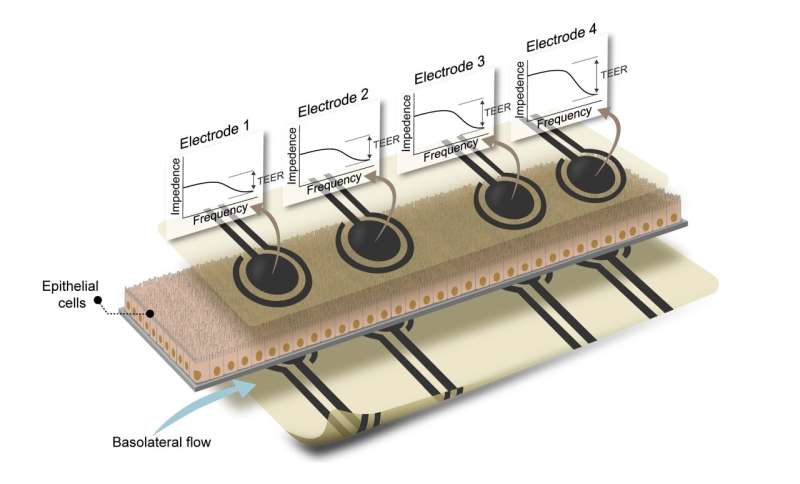This article has been reviewed according to Science X's editorial process and policies. Editors have highlighted the following attributes while ensuring the content's credibility:
fact-checked
peer-reviewed publication
proofread
Multi-electrode integration in gut-on-chip systems enhances intestinal barrier monitoring

To enhance the fields of drug development and medical research, there has been a strategic pivot from traditional animal experiments to the adoption of novel in vitro models. These models meticulously replicate human physiology, spurring the development of microphysiological systems or Organs-on-Chips.
This evolution presents a more ethical and sophisticated framework for investigating human organs and diseases, accurately simulating organ functions and enabling detailed studies of tissue and organ health without the moral quandaries associated with animal testing. Specifically, the gut-on-a-chip model emerges as a cutting-edge tool for investigating the intestinal barrier's reaction to a myriad of factors, utilizing advanced techniques like transepithelial electrical resistance (TEER) for the real-time assessment of barrier integrity.
Published on January 24, 2024, in Microsystems & Nanoengineering, a study showcases a method to enhance intestinal barrier monitoring within the Human Microbial Crosstalk (HuMiX) gut-on-a-chip model.
This method facilitates real-time, spatially resolved measurements of TEER, offering direct insights into the gut barrier's integrity. By overcoming the limitations of previous designs, the research team introduced a novel fabrication process that applies thin-film metal electrodes onto flexible substrates, which are then seamlessly incorporated into the HuMiX platform via a transfer-tape method.
This innovative setup allows for comprehensive monitoring of barrier formation, disruption, and recovery, detailing the cell culture area's different sections. The strategic placement of electrodes navigates the platform's intricate design, ensuring accurate and reliable data collection. The application of impedance spectroscopy enhances this data, enabling measurements across various frequencies.
Demonstrating the system's efficacy, the researchers conducted real-time monitoring of a cancerous epithelial cell line's barrier formation, underscoring the model's potential to shed light on gut health and disease pathways.
Researchers from the University of Luxembourg and the University of Uppsala collaborated on this study and underscore the significance of this advancement, "This technology significantly advances our capability to monitor the gut barrier function in real-time, offering insights into the complex interactions between gut epithelial cells and the microbiome. This marks a considerable leap towards the realization of personalized medicine and the formulation of targeted interventions for gut-related conditions."
This novel method of monitoring the formation and integrity of the gut barrier heralds a new era in gut health research. It profoundly influences our comprehension of the gut barrier's reaction to various stimuli, paving the way for the innovation of therapeutic approaches for gut-related diseases. Moreover, its implications for personalized medicine are profound, enabling precise predictions of individual reactions to dietary adjustments or medical treatments.
More information: Mara Lucchetti et al, Integration of multiple flexible electrodes for real-time detection of barrier formation with spatial resolution in a gut-on-chip system, Microsystems & Nanoengineering (2024). DOI: 10.1038/s41378-023-00640-x
Journal information: Microsystems and Nanoengineering
Provided by TranSpread




















